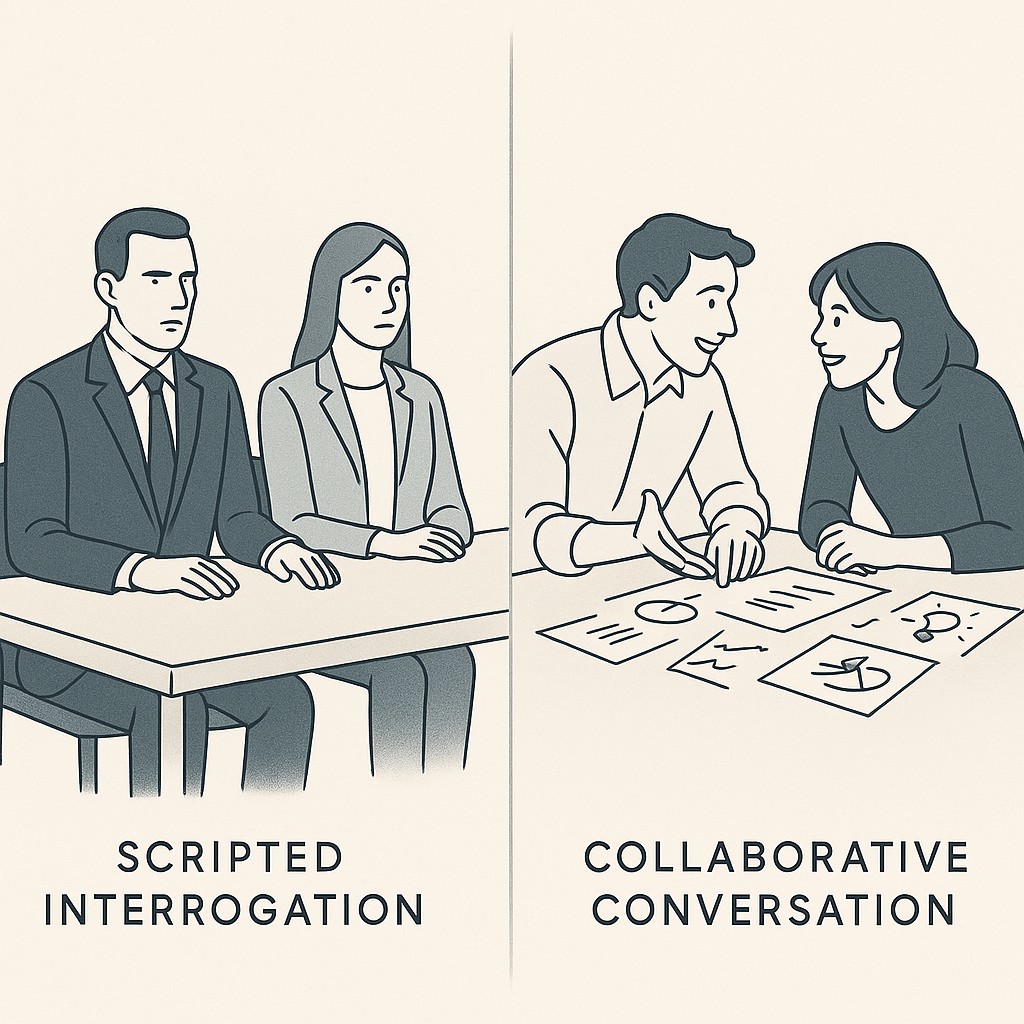High-Signal Engineering Interview Questions: Turning Ambiguity Into Collaboration
High-Signal Engineering Interview Questions: Turning Ambiguity Into Collaboration

When Interviews Turn Into Collaboration
High-signal engineering interview questions led to one of the best interviews of my career a few months ago. Here’s how it started. I laid out our team’s actual workflow—fast shipping, lots of loose ends, changes flying in—and without missing a beat, the candidate cut in with clarifying questions. Not just about the technology, but about how decisions got made, what “delivery” actually looked like, where things typically broke down. I was halfway through my polished list of questions when I realized we were off script. The session shifted from interrogation to exploration so quickly I almost didn’t catch the transition. Truthfully, I was surprised at how fast they’d steered us into problem-solving.

Early on, interviews for me ran strictly by the playbook: structured formats, checkboxes, everything tightly scoped. It felt fair and controllable, less stressful for everyone. But the signal was always thin. Candidates who nailed the format sometimes floundered on real teams, and promising people often got squeezed out because they didn’t fit the script.
Then came the shift. That day, after a few minutes, the conversation flipped. The candidate asked for more context, poked at unclear requirements, reframed pieces of the problem, and talked through tradeoffs out loud. It stopped feeling like an interview and started feeling like a working session. They taught as they reasoned, outlining what they knew, what they didn’t, and how they’d narrow things down from here. No prompt required. That’s when the actual depth showed up—not the answer, but the process. I sat back and watched as they untangled ambiguity, built structure, and brought me along for the ride. I’ve since noticed this is the moment I learn what it’s actually like to work with someone.
That’s when I realized. The strongest interviews aren’t about having the right answers. They’re about practicing ambiguity-based interviewing—turning uncertainty into conversation and seeing how someone creates clarity where there isn’t any.
Stick with me. I’ll lay out how you can design interviews that surface curiosity, teaching, and collaboration, without losing consistency or fairness.
Why Clever Puzzles Miss What Matters
I’ve interviewed hundreds of engineers, and the high-signal engineering interview questions that tell me the most aren’t clever or complex. I used to think brainteasers or rapid-fire technical drills would smoke out talent. But time and again, those signals never held up on the job. Here’s the thing: “We found that brainteasers are a complete waste of time,” Google’s own internal reviews admitted as much, which says a lot about what actually matters when you want a strong, reliable team. If I walk away from an interview with nothing but a list of right-or-wrong answers, I know I missed what counts—judgment, curiosity, and genuine collaboration.
Let’s be blunt. Most puzzles just measure recall under pressure. You get a tiny, shaky glimpse of someone’s brain in a corner they’ll rarely be in. Ambiguity works differently. Open-ended scenarios—where the requirements are gray and the solutions undefined—show how people create clarity. It’s the difference between measuring someone’s sprint speed and watching their pacing over a five-mile run. Putting people in real-world scenarios emerges as more effective, on average, than chasing proxies like abstract psychological constructs judged relevant to the job.
The prompts that actually work are open-ended interview questions—opinion-driven and sometimes deliberately incomplete. I’ll ask something broad like “Where would you start refactoring this?” or “How do you think about scaling this system?” That last piece—the need for opinion—is crucial, because it forces candidates to reveal the tradeoffs they’ve lived through. You get their actual thinking, not a rehearsed “best practices” script.
Here’s the mechanism. When you drop a vague, opinion-led prompt, candidates have to lean in. They start by drilling into what’s missing, asking clarifying questions, sometimes challenging the way the problem’s even framed. Suddenly you’re getting them to reason out loud, not just recite knowledge. The best ones teach as they go, pausing to explain real tradeoffs, talking through how constraints would change their approach. If I open with “What do you like and dislike about [X]?” I watch for what gets clarified, what gets skipped, what they prioritize. It’s not trivia; it’s how they approach uncertainty. This is what you want exposed—how someone thinks without a net, the mental scaffolding they put up when no solution is given.
For practical evaluation, you want to listen for how candidates probe for context, spot constraints, and frame options clearly. It’s most obvious on concrete topics—Tailwind, Terraform, feature flags, whatever your team uses. If I say, “We’ve been running into issues with X. What are your thoughts?” and they start with, “Can you share how you’re using it today?” or “What bottlenecks stand out?”—that’s the signal. The mechanics of real collaboration shine through.
Turning Open-Ended Prompts into High-Signal Engineering Interview Questions
Here’s the structure I lean on now. Start the interview with a deliberately incomplete, opinion-led prompt—something that’s open enough candidates have to ask for more context if they want to dig in. As the conversation warms up, shift into a more scoped technical scenario so you can watch how they wrangle specifics under light constraints, without stripping away all ambiguity. Finally, toss in a curveball or two once they’re rolling (a new requirement, changed priorities, something unexpected) to see how they adapt and recalibrate. You want this whole arc to feel conversational, not scripted.
The magic is in keeping the format loose enough for genuine problem-solving. If you want proof that it works, remember: open-ended, constructed-response formats on situational tasks are harder to game and do a better job distinguishing who genuinely stands out.
Let’s anchor this in something tangible. Ask about Tailwind. Invite their opinions on utility-first CSS—what’s great about it, where they find it limiting, how component reuse interacts with team conventions. You’re not looking for them to recite documentation; you want them to show taste, grapple with constraints, and weigh tradeoffs out loud. “Would you recommend Tailwind for component-heavy projects?” That question alone surfaces how they’ve wrestled with real friction.
Same principle with Terraform. Toss out a scenario: “We’re running into environment drift, and state management is getting hairy. How would you approach module reuse?” I pay attention to who stops to clarify what’s actually broken or why changes are risky before jumping to a fix. Candidates who can frame the problem accurately before suggesting a path forward nearly always have scar tissue from living through real incidents.
Quick tangent. There was one call last year—I forget the exact month, but the candidate surprised me by bringing up how his team once tried mapping infrastructure changes by hand on sticky notes before CI/CD. The discussion veered into a story about the wall slowly filling up with pink notes until nobody could tell which was the most recent, and eventually they only trusted the person who physically stuck it up. On the surface, it had nothing to do with Terraform, but the way he traced the pain points and project adjustments made the scenario richer. I keep thinking about how little moments like that, improvised and off-script, hint at a candidate’s experience dealing with ambiguity and change.
I’ll sometimes ask, “Teach me something technical, like I’m non-technical.” This flips the frame and lets you gauge how they scaffold ideas, lean into analogies, and show humility. It’s one thing to know a topic; it’s another to build understanding for someone outside your domain. You learn just as much from how they explain as from what they choose to explain.
If you’re designing interviews from scratch, lean into these vague, high-context prompts. Watch for curiosity, teaching, and real-world collaboration. When candidates clarify, reason aloud, and recalibrate on the fly, you’re no longer guessing—you’re hiring for how they’ll actually perform. That’s the signal worth chasing.
Making Fair Collaboration Interviews Repeatable
Let’s name the worries up front. Is this fair? Does it eat up too much time? I had the same doubts—honestly, I worried we’d drift into vibes or gut feel, skipping hard criteria. What kept us grounded was mapping interview signal directly to observable dimensions. Curiosity, communication, tradeoff framing, and collaboration. It’s not just about ticking boxes; it’s scoring what you actually see. You watch for specifics. How often do they ask clarifying interview questions? Do they build structure as they go? Do they make tradeoffs visible without being prompted? Put it all on a rubric so behaviors stay crisp and scoreable.
You want behavioral anchors. The strong candidates jump right in with pointed clarifications, walk through problems step by step, and teach using analogies that fit. Weak looks like rambling or avoiding details; strong is crisp, relatable reasoning. To assess reasoning in interviews, every axis—questions, reasoning, teaching—gets scored from “not present” to “crystal clear,” so you’re not hand-waving “good enough.”
To keep everything comparable, stick to the same core vague prompt for each interview. For instance, use the same Tailwind or Terraform scenario, scoped so everyone’s starting from the same spot. Then, inject a standard curveball along the way—a shifting requirement, a sudden deadline—to watch how they adapt. Last quarter, we started this and saw signal stabilize. Once framing cut down the back-and-forth cycle, output got consistent interview to interview.
This may seem like splitting hairs, but here’s the anchor. You’re hiring for character and collaboration, not just rote technical knowledge. Who people are—and how they work with uncertainty—is what lifts teams and speeds up execution. That’s what you want fit to signal in the room. I still wrestle with whether this process can catch every nuance, especially with remote interviews. There always seems to be one variable we haven’t nailed down. I wish I had a perfect answer, but I don’t.
Concrete Prompts and a Consistent Working Session Format
If you want to pilot this approach, start simply. Open with, “We’ve been running into issues with X. What are your thoughts?” Let that starter hang. See what they ask, where they push for more context. Next, layer in a “What do you like and dislike about [X]?” for taste and depth. Drop a scoped scenario (“Suppose deadline shifts, and X must roll out next sprint—what’s your move?”). Mix in a curveball (suddenly, a new dependency breaks). End with a teaching prompt (“Explain how you’d approach this to a teammate who’s new”). Each step helps you watch for clarity, collaborative interview problem-solving, and their ability to recalibrate mid-stream.
Here’s a format you can run in 45–60 minutes, no elaborate prep needed. Kick off with the starter (“We’ve been running into issues with X”) and watch how quickly they ask clarifying questions. Move into a scenario. Set up the problem, invite their approach. Toss a curveball mid discussion. Then ask them to teach (break down their approach as if mentoring a junior engineer).
Wrap up by inviting their reflections on tradeoffs and what they’d do differently with more time or context. Score what you see on a simple sheet. Did they clarify context, reason aloud, adapt under changing requirements, and scaffold explanation for others? I keep coming back to the same thing: the curious, humble, opinionated-but-open candidate will lift your team more than raw coding horsepower ever will.
Turn your raw ideas into polished posts, threads, and summaries with AI that adapts to your goals, constraints, and tone, so you can publish faster and spend more time building.
Don’t treat ambiguity like a bug. Design interviews that turn it into conversation. When you do, you’ll watch mis-hires drop and team execution accelerate. Give it a run in your next loop.
Enjoyed this post? For more insights on engineering leadership, mindful productivity, and navigating the modern workday, follow me on LinkedIn to stay inspired and join the conversation.
You can also view and comment on the original post here .
